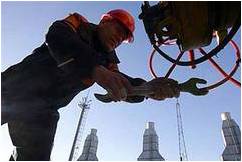
On June 3, the president of the State Oil Company of Azerbaijan Republic (SOCAR), Rovnag Abdullayev, said that by the 2020s, gas production in Azerbaijan will reach around 40 billion cubic meters per year (bcm/a) (News.az, June 3), from the current level of 30 bcm in 2015, according to the latest estimates (Contact.az, June 9). New volumes of gas will come from non–Shah Deniz fields and prospective projects, which are currently under various stages of exploration, appraisal and development. These coming volumes will make up the next wave of production in the country.
According to this author’s independent research carried out for the Oxford Institute for Energy Studies (OIES), during the 2020s, the volumes of “free” un-contracted Azerbaijani gas available for export may reach around 15 bcm/a. This will come from both proved reserves and potential resources. They will include gas fields (commercial reserves) that are in production and also discoveries subject to further appraisal, considered to be contenders for development in the near to medium term, i.e. by the 2020s (that is, probable developments). The South Caspian deep water fields and blocks that fall into this latter category include: Absheron, Azeri-Chirag-Guneshli Non-Associated Gas (ACG NAG), and Umid and Babek. Production growth from these projects will depend on securing gas sales contracts with suitable buyers, the availability of drilling rigs, the commerciality of the projects themselves and the availability of infrastructure, i.e. the availability of free capacity to transport additional volumes to markets (Gulmira Rzayeva, “The Outlook for Azerbaijani Gas Supplies to Europe—Challenges and Perspectives,” Oxfordenergy.org, June 1).
Nonetheless, these accumulations have a high likelihood of development due to having the following attributes:
- existing or likely development plans;
- geological complexities resolved or partially resolved by exploration drilling and reservoir studies;
- the decision of the Azerbaijani government on fields that will be granted priority usage of a new semi-submersible drilling rig early in 2017 (once constructed); and
- the stated commercial interest of the partners to complete appraisal and subsequent development works.
Taking into account the factors affecting timing, specifically the current development status of the four projects, the front-runner likely to reach a final investment decision (FID) and achieve first production is the Absheron field. The gas field’s current participation includes SOCAR with 40 percent, French Total—40 percent, and French multinational GDF Suez (since renamed Engie) with 20 percent. Preliminary estimates put Absheron reserves at 80–200 bcm of natural gas and 45 million tons of gas condensate with annual production of 5 bcm.
Absheron is the only project that has secured a production sharing contract (PSC). Exploration drillings have been completed, and currently the field is in interim status as there is a shortage of semi-submersible drilling rigs to start appraisal drillings. All three available rigs are currently in use at the Azeri-Chirag-Guneshli and Shah Deniz fields. For this reason, and based on the results of its exploration well, Total has decided to proceed directly with the phased development process, potentially avoiding a delay of around four years. Current first production is estimated for late 2021, with an FID in late 2017 (Rzayeva, Oxfordenergy.org, June 1).
Moreover, SOCAR’s vice president for upstream, Khoshbakht Yusifzade, announced earlier this month that a drilling rig being built by the Korean Keppel Fells company, which will be ready by 2017, is going to be transferred to Total for development drilling at the Absheron field, thus potentially resolving the problem of rig shortages there (Abc.az, June 4).
After Absheron, the second contender for non–Shah Deniz production is the Umid/Babek field/perspective structure for which SOCAR has announced a tender in September 2014 to attract foreign investment (News.az, September 10, 2014). However, no PSC has been signed yet. Preliminary estimates put Umid reserves at 200 bcm and 225 million barrels of condensate. Babek pre-drill estimates by SOCAR are 400 bcm and 80 million tons of condensate. Currently, the Umid field has two wells in operation, which produce about 566.2 million cubic meters per year, or 47,000 thousand cubic meters per month, which is used for domestic consumption. The project’s appraisal and development phase will most likely start after the Absheron field, in 2018–2020, and take approximately eight years. Consequently, the projected timeframe for the Umid/Babek field’s production might be by 2026–2027. Considering the size of the field and the project’s lifetime (approximately 25 years) it is projected that the annual gas production from the Umid field will be somewhere around 1.5 bcm/a and from the Babek field around 3–5 bcm/a (Rzayeva, Oxfordenergy.org, June 1).
The third prospective production field is the ACG NAG, which is not yet covered by the terms of the existing ACG PSC. Negotiations are ongoing with the ACG partners to define the contract area specific to this gas potential. A contractual/legal decision in 2015 would imply a potential development start date of 2019–2020 and first gas in 2027–2028. A reservoir of non-associated natural gas, estimated to contain some 280 bcm of natural gas and 50 million tons of gas condensate is located below the oil deposits. Given the size of the field and its lifetime of approximately 25 years, it is estimated that annual production will be approximately 4–5 bcm of natural gas.
Yearly domestic demand in Azerbaijan is around 10 bcm, and it is most likely to grow to no more than 15 bcm/a by 2030. By 2018, total gas production in the country is planned to reach 25 bcm (from the Shah Deniz field, excluding associated gas and SOCAR’s portfolio), and the un-contracted gas volumes available for new exports could reach up to 15 bcm/a by the late 2020s from the fields/blocks described above. Thus, Azerbaijan is on track to become a significant natural gas exporter in the coming decade.
By: Gulmira Rzayeva
 Oval Useful news from Azerbaijan and Caucasus
Oval Useful news from Azerbaijan and Caucasus


